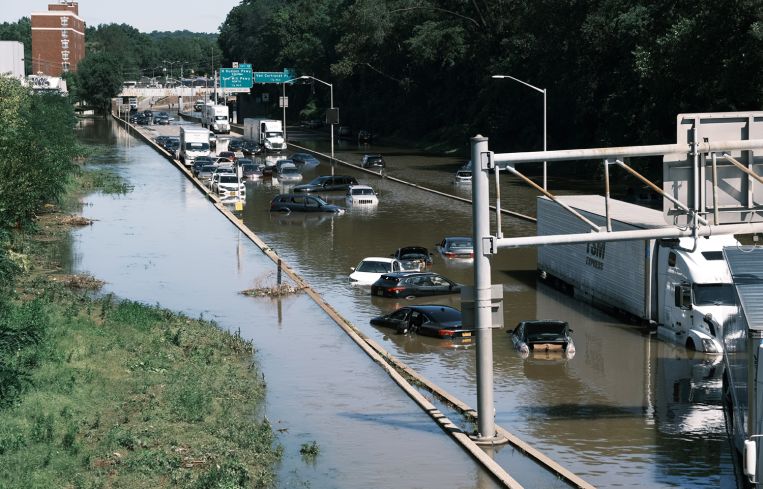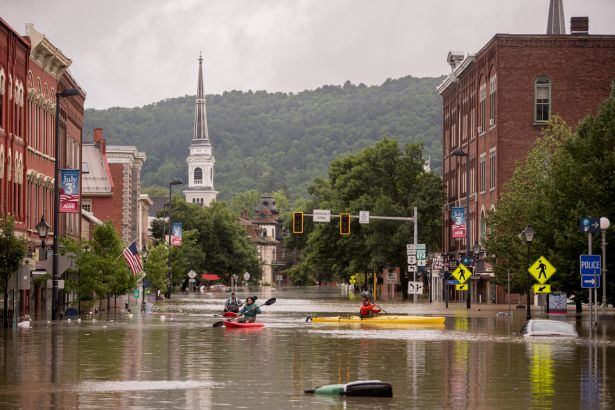Northeast Flooding Confronts Commercial Real Estate With Severe Challenges
Many parts of the region were not built for the sorts of storms now regularly hitting it
By Anna Staropoli August 28, 2023 6:00 am
reprints
This summer, the United States confronted a deluge of wildfires, floods and heat waves that battered cities nationwide — including locations that least expect it.
In the Northeast, Vermont was inundated by a two-day July storm that pummeled sections of Montpelier, the state’s capital, and rural towns. Simultaneously, catastrophic rains struck other New England states, as well as parts of Pennsylvania and New York, resulting in widespread damages, evacuations and even death.
For a summer deemed the hottest on record, the rainfall-driven flooding was hardly a reprieve from the severe heat, causing its own kind of damage and destruction to infrastructure, crops and homes.
These deluges have forced the Northeast to weather severe weather — and reckon with a future it was not designed for. Unlike coastal states, or the lowland Southern region bordering the Gulf of Mexico, Vermont and Pennsylvania both sit inland in areas that, at first glance, are less at risk of flooding.
But that calculus may no longer be accurate. “We are all affected by climate change, and we all need to take action to preserve our future,” said Josh Knauer, co-founder of ReSeed, a carbon asset provider.
Of course, the future, and its risks, vary tremendously based on location, said Karl Fippinger, vice president of fire and disaster mitigation at The International Code Council (ICC), which sets international standards for the building industry.
In Vermont, it’s not proximity to water but topography that creates vulnerability. The Green Mountain state is, of course, known for its green mountains, whose steep terrain can’t rapidly absorb rainwater. So, in the event of extreme rain, water gathers, builds and ultimately inundates the lowland valleys — which is what happened in July.
“It’s a very unique set of circumstances, wherein if you had somewhere that was fairly flat or less mountainous, you may not have seen the same kinds of impacts as you saw in Vermont,” said Fippinger. “The velocity was pretty high based on the elevation and the terrain.”
The July floods in the Northeast were only the most recent indication of the risks to the region, which can be attributed to climate change. Global flood intensity has sharply increased over the last 20 years. In the United States, coastal flooding has doubled, while floods have reached new extremes in the Mississippi River Valley, the Midwest and — yes — the Northeast, according to a report by the Natural Resources Defense Council.
“These inland flooding events have shifted the perception of where the flood risk really is more near term,” said Ben Myers, vice president of sustainability at developer Boston Properties (BXP).
Underprepared
While most areas of the United States need to improve their storm readiness, the Northeast is unique in how underprepared it is.
“The Northeast, specifically though, is woefully not ready for this,” Knauer said.
Some of that deficit is due to a somewhat complacent mindset toward rare but devastating floods. “One of the things with flooding is that it’s quite easy to have a short memory of it,” said Adam Rimmer, co-founder and CEO at flood insurance company FloodFlash. “[But] it is the rare events that, when they do happen, cause the most catastrophic damage to businesses, to communities and to livelihoods.”
Beyond inland risks, the American Northeast is also prone to coastal flooding. Hurricane Ida — a 2021 Category 4 storm that hit the Gulf Coast before shifting Northeast — and 2012’s Hurricane Sandy exemplified the pitfalls of complacency, said Vincent Lee, a principal and the east civil and water leader at Arup in New York.
Lee pointed to the example of 2021’s Hurricane Henri, which preceded the catastrophic Hurricane Ida later that year. Hurricane Ida was an eye-opener for the East Coast, as it hit places that ordinarily did not experience significant flooding, said Lee. While Hurricane Henri was damaging, it was downgraded to a tropical storm, so by the time Hurricane Ida hit days later, many New Yorkers had let down their guards. “What happens sometimes is that people will experience a storm, and then it’s not that bad,” he said.
Unlike with wind, which tends to cover a broad area uniformly, flood impact can vary greatly based on elevation and infrastructure, said Rimmer.
This inconsistency can further fuel complacency and leave people unprepared for catastrophe. “I think many in the Northeast felt safe from climate change,” said Knauer. “The Northeast has a lot of factors associated with it: lots of trees, lots of complex weather patterns that have been changing, but maybe not as severely as we have seen in California.”
Like Vermont, California has recently grappled with unprecedented levels of flooding. After a prolonged period of drought last fall, the Golden State accumulated a record level of snowpack beginning in December 2022. By March, that snow contained 234 percent more water than normal. Melting snow, together with rain spurred by atmospheric rivers, led to extreme flooding across the state, resulting in widespread damage to both infrastructure and crops, as well as evacuations and death — catastrophes not unlike those Vermont is now experiencing.
Both of those states, as well as New England at large, have seen 100- or even 1,000-year flood events that are becoming increasingly common, said Fippinger. “Flooding is a problem almost everywhere,” he said, “which is becoming, once again, the new normal.”

Infrastructure
In addition to prevention, thinking about recovery from rare but extreme events is paramount, said Rimmer. Both physical and financial resilience measures — like a raised electrical circuit, physical flood barriers and flood insurance — are crucial, but may not be a priority if you view flooding as a rare, unlikely occurrence.
“Some of the flooding that we’ve seen in Vermont, for example, is these high-impact rainfall events coupled with inadequate stormwater infrastructure,” said BXP’s Myers. “You have geographies that have lots of topography. So there’s all this water being channeled into these towns, and no stormwater infrastructure to handle that water.”
“There’s just all kinds of infrastructure that we do not have and we’re not prepared for in dealing with the types of large-scale flooding that are coming,” said Knauer.
In New England, history may help explain infrastructural deficits. As an early-settled region with a lot of older construction and infrastructure, New England’s built environment tends to be lower-lying and more prone to flooding, said Fippinger.
Newer buildings generally see less risk than existing buildings constructed prior to current knowledge about flooding. Both New England and Vermont have building codes that are less than a decade old, so buildings constructed since those new codes were implemented will be informed by updated flood elevation maps and more up-to-date climate research, said Fippinger.
As for international codes, which are adopted across the country, flood-risk maps from the Federal Emergency Management Agency (FEMA) and other government entities help inform base flood elevation for construction. “There are structural requirements and flood loading requirements that are in the international codes that are really driven by the hazard, the risk and recurrence interval,” said Fippinger.
Farmland
Flood risks are not limited to the built environment. In Vermont, July’s flooding brutalized both homes and farmland, destroying at least 10,000 acres of crops.
“It’s becoming an eye-opener now for rural areas in terms of: How do we deal with all of this extreme runoff?” said Lee.
Because the water can drain off, undeveloped land is generally better prepared for extreme weather conditions than the built environment, said Rimmer. However, as evidenced by Vermont, the land often can’t sustain the amount of rainwater at the pace and intensity of the recent floods.
Flood events are particularly detrimental to land that isn’t maintained and lacks natural ecosystems, said Knauer. Rain wipes away topsoil, so any chemicals or sediments that have been applied to farmland are then pushed downstream. “That damages water infrastructure, which causes more flooding and causes overflow of and redirection of rivers and all kinds of serious problems in a watershed,” said Knauer. “Basically, it is like a wall of water hitting these small towns along the way, and we saw this happen in Vermont just recently.”
To address this risk, Knauer recommends solutions that cover the entire ecosystem and watershed. For example, new gardening and landscape techniques can create healthier soils, while alternative farming practices can improve water retention in soil.
Knauer believes his company offers “market-based” solutions, meaning ReSeed encourages more regenerative farming practices that improve water retention, while also helping farmers profit off their changed practices. This incentivization is done through the purchase of carbon credits, which homeowners and business owners can buy from the farmers.
Across the country, market-based solutions will be the fastest way to solve these problems, said Knauer. “That’s a language that many, most all, anyone in the real estate industry should understand.”
The commercial component
In general, commercial real estate tends to be better prepared for flood events. First, commercial properties are often better equipped for storm management than single-family homes.
“[Flood preparation] differs quite a bit by asset class,” said Myers. “Single-family residential owners and coastal communities don’t have the resources to respond. So the most vulnerable properties, I think, in the near term are gonna be single-family residential properties that are coastal.”
In addition, larger-scale commercial buildings often have better insurance and opportunities to pivot from a given catastrophe. They also must comply with regulations in ways that residential homes do not, said Myers. Even so, more than 80 percent of the world’s flood damage goes uninsured every year, said Rimmer, whose clientele is primarily commercial.
Solutions
Flood preparation comes down to a series of risk-management strategies for cities and commercial landlords — for which there is no one-size-fits-all approach across geographies.
It’s up to each city to invest in infrastructural improvements, nature-based installments and creative solutions for building, retrofitting and future-proofing properties. Many of these approaches require partnerships between the cities that deal with infrastructure, the developers who manage property improvements and the users who occupy a given property.
“I think in large part the cities know what the answer is,” said Lee. “I think cities are recognizing that it’s the infrastructure that they sort of own and manage that needs to be upgraded.”
Myers’ BXP, for example, recently undertook a project in Needham, Mass., to install a solar canopy over a garage, using on-site drainage to relieve some of the stormwater outflow impact. Development projects like these can help catalyze stormwater system improvement, said Myers. As cities improve their modeling and risk management, they can better foresee where localized flooding may occur and how it will impact stormwater infrastructure, Myers predicted.
Extreme flood events in the Northeast may speed up this process. “They’re shots across the bow that we can’t ignore,” said Myers, “And they push us beyond our ability to cope in certain jurisdictions.”
Right now, the Northeast has a significant opportunity for change and improvement, said Fippinger, who pointed to both political will and federal and state funding as harbingers for change. After all, “It’s not if the next flooding event is going to happen,” said Fippinger, “but when.”
Anna Staropoli can be reached at astaropoli@commercialobserver.com.


